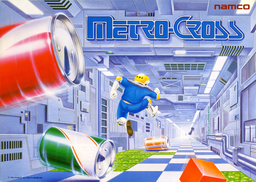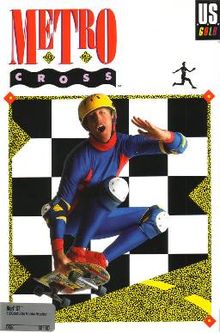- Metro-Cross
-
Metro-Cross 
European arcade flyer of Metro-Cross.Developer(s) Namco Publisher(s) Namco Designer(s) Tatsurō Okamoto (岡本達郎) Platform(s) Arcade, Amstrad CPC, Atari ST, Commodore 64, Famicom, ZX Spectrum Release date(s) 1985 Genre(s) Platformer Mode(s) Up to 2 players, alternating turns Cabinet Upright, cabaret, and cocktail Arcade system Namco Pac-Land Display Horizontal orientation, Raster Metro-Cross is an arcade game, released by Namco in 1985. It runs on Namco Pac-Land hardware (but with a video system like that used in Dragon Buster), modified to support a 2048-color palette. It uses a 6809 microprocessor, a 63701 microprocessor, and a Namco 8-channel waveform PSG for sounds.
Contents
Gameplay
Metro-Cross is a platform game where the player must run through 32 futuristic levels. He is given a time limit to run through each one while avoiding obstacles and collecting items. The actual running happens automatically, the job of the player is to dodge obstacles and collect items by moving the character sideways and adjusting the speed.
If the character finishes the race within the time limit, the remaining time is converted into bonus points and he moves on to the next track. Every fourth track is a special track, which uses the time left over from the previous three as additional time. However, if the character hasn't reached the finish line when the time limit is up, the game is over.
Obstacles along the way include glass panels, which break under the character's weight and drop him to a hole, and steam jets which shoot steam at the character. Landing on a glass panel and pushing forward on the joystick, however, creates an extra long jump. Later tracks also feature balls that bounce along the track and must be avoided. Colliding with an obstacle results in a penalty of a few seconds. Later levels include frogs that attempt to jump on you and slow you down. If 3 frogs jump on you at the same time, you are reduced to a very slow speed.
Also along the track are springboards, which can be used to propel the character forward at a great speed. Some tracks have a special layout of springboards, where it is possible to use a springboard to land directly on another one. Some tracks also have skateboards which speed the character up and make him immune to some obstacles. There are two colours of cans found along the track. Kicking the cans gains bonus points, but jumping on them and knocking them over activates a special effect. Jumping on a blue can stops the timer for a few seconds, and jumping on a green can gives an extra burst of speed.
Ports
The game was successfully converted to various home formats, including the Commodore 64, Atari ST, Amstrad CPC, NES and the ZX Spectrum. It appears on Namco Museum Volume 5 for PlayStation and Namco Museum Virtual Arcade for Xbox 360. A new high definition version ("Aero-Cross") is being developed for Xbox Live Arcade and PlayStation Network as part of the new Namco Generations line.[1]
References
External links
Categories:- 1985 video games
- Amstrad CPC games
- Arcade games
- Atari ST games
- Commodore 64 games
- Namco games
- Nintendo Entertainment System games
- ZX Spectrum games
Wikimedia Foundation. 2010.


